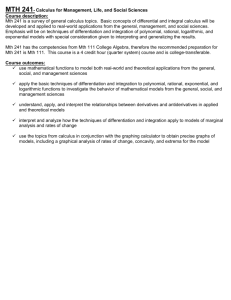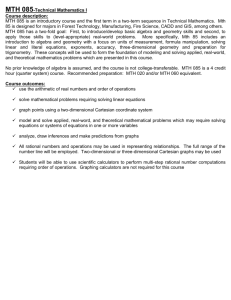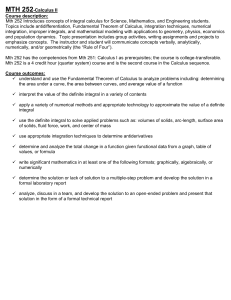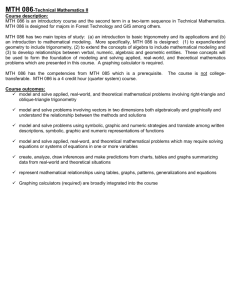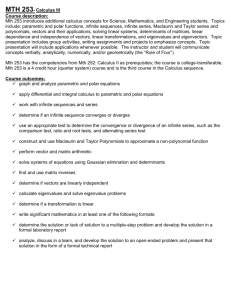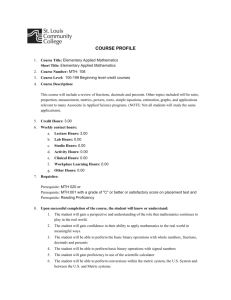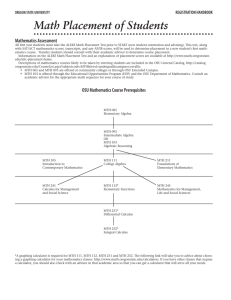Undergraduate Mathematics at OSU
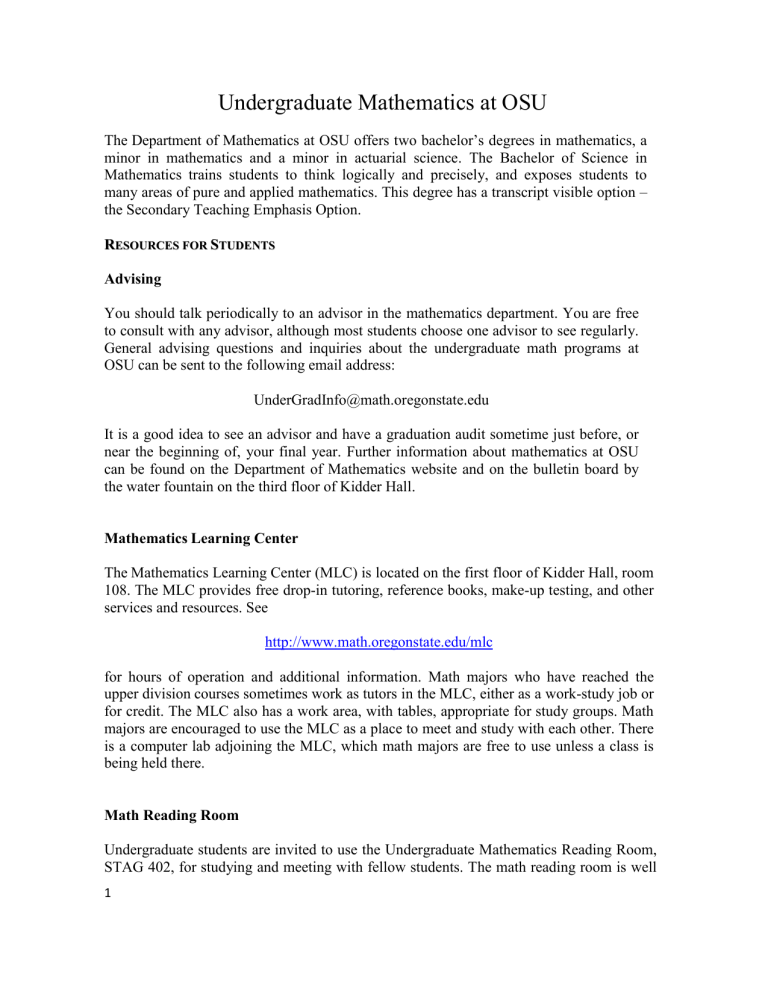
Undergraduate Mathematics at OSU
The Department of Mathematics at OSU offers two bachelor’s degrees in mathematics, a minor in mathematics and a minor in actuarial science. The Bachelor of Science in
Mathematics trains students to think logically and precisely, and exposes students to many areas of pure and applied mathematics. This degree has a transcript visible option – the Secondary Teaching Emphasis Option.
R E S O U R C E S F O R S T U D E N T S
Advising
You should talk periodically to an advisor in the mathematics department. You are free to consult with any advisor, although most students choose one advisor to see regularly.
General advising questions and inquiries about the undergraduate math programs at
OSU can be sent to the following email address:
UnderGradInfo@math.oregonstate.edu
It is a good idea to see an advisor and have a graduation audit sometime just before, or near the beginning of, your final year. Further information about mathematics at OSU can be found on the Department of Mathematics website and on the bulletin board by the water fountain on the third floor of Kidder Hall.
Mathematics Learning Center
The Mathematics Learning Center (MLC) is located on the first floor of Kidder Hall, room
108. The MLC provides free drop-in tutoring, reference books, make-up testing, and other services and resources. See http://www.math.oregonstate.edu/mlc for hours of operation and additional information. Math majors who have reached the upper division courses sometimes work as tutors in the MLC, either as a work-study job or for credit. The MLC also has a work area, with tables, appropriate for study groups. Math majors are encouraged to use the MLC as a place to meet and study with each other. There is a computer lab adjoining the MLC, which math majors are free to use unless a class is being held there.
Math Reading Room
Undergraduate students are invited to use the Undergraduate Mathematics Reading Room,
STAG 402, for studying and meeting with fellow students. The math reading room is well
1
equipped with tables, couches, white boards, computers, microwave and refrigerator. Select undergraduate members of the OSU student chapter of Pi Mu Epsilon (the National
Mathematics Honor Society) are available for consultation in the reading room (during select hours), as peer mentors. The room is maintained by officers of the OSU math club and Pi Mu Epsilon; the hours during which it is open vary by term.
D
E G R E E P
R O G R A M S
The Department of Mathematics offers two undergraduate majors and two minors. The
Department of Mathematics is a unit within the College of Science, which is one of 11 academic colleges at OSU. The College of Science and the university have certain requirements for a bachelor’s degree. For example, a student must earn a total of at least
180 credits, at least 60 of which must be upper division. Each student must complete
OSU’s general education program, the Baccalaureate Core, and must satisfy the requirements for a major in some subject. The details of the university and college requirements are available in the OSU catalogue and various other publications. All students can track their progress toward degree online using the MyDegrees program audit system. For more information and access to the login page, visit the following page: http://oregonstate.edu/registrar/mydegrees/home .
All math majors take certain core courses. The lower division courses (those numbered lower than 300) and math 341 are usually taken during a student’s first two years. These requirements total only 45 credits, so most of the university baccalaureate core can also be completed during these first two years. Some of the courses required for the math major will simultaneously satisfy requirements of the baccalaureate core.
If a student does not place directly into the calculus sequence as a freshman, he or she can still complete the lower division courses during the first two years, as some terms in the calculus sequence can be taken simultaneously. A flow chart for the prerequisites in the calculus sequence follows. The 6 term sequence can be completed in 4 terms if need be.
251 252 253 255
254 256
Alternately, if a student arrives at OSU with credit for some calculus, he or she may be able to complete the lower division requirements in one year. In this case, the student may wish to begin what we call the “junior core” during his or her second year here.
The junior core consists of six courses, which all math majors must take. Each of these courses is (expected to be) offered during the term indicated in the checklist. In addition to the junior core, 7 more upper division courses are required. Math majors gain breadth of knowledge by choosing five of these courses from a diverse list of mathematical topics.
The requirements for the major and minor programs are summarized beginning on
2
3 page 4 of this pamphlet. Individual check lists are available on-line.
Students who plan to teach mathematics in middle or high school may earn a transcript visible option in education. The 400-level math courses required for the education option are different from those required for the math major. Future teachers also are required to take two courses in math education that will help prepare them for a graduate program in education and teacher licensure. Students earning the education option who desire a stronger background in mathematics are encouraged to take some of the senior level core math courses as electives. The requirements for the math major with the education option are described in a checklist on page 5 of this pamphlet. An individual check list for this option is available on-line.
Minor Programs in Mathematics
The Department of Mathematics at Oregon State offers a minor in Mathematics and a minor in Actuarial Science. The minor in Actuarial Science offers courses of interest to the financial and actuarial industries. The minor helps students prepare for the first examination administered by the Society of Actuaries. More information about this program is available at http://www.math.oregonstate.edu/Actuarial_Science_Program or by sending a message to ActurarialInfo@math.oregonstate.edu
.
For more information about the minor programs in mathematics contact an undergraduate advisor in the Department of Mathematics at
UnderGradInfo@math.oregonstate.edu
.
Requirements for both minor programs are described in a checklist on page 6 of this pamphlet. Further information about both minor programs can be found on the
Department of Mathematics website.
Checklist for the Bachelor of Science in Mathematics :
Listed below are the requirements for the math major portion of the Bachelor of Science in
Mathematics. Students will also need to satisfy the requirements of the university and the
College of Science to earn a degree. Frequent consultation with an advisor is recommended to monitor timely degree completion.
A grade of at least C– and a GPA of 2.25 are required in all upper-division mathematics courses used to fulfill degree requirements. An OSU GPA of 2.00 is required by the College of Science. No course used to fulfill requirements for your major may be taken “S/U.”
Lower Division:
MTH 251 - 256
Physics 211
MTH 341
Upper Division:
MTH 311 (F)
MTH 355 (F)
MTH 312 (W)
MTH 342 (W)
MTH 343 (S)
WIC
1
(S)
The Calculus Sequence (MTH 251, 252, 253, 254, 255, 256)
General Physics with Calculus
Linear Algebra I
Advanced Calculus I
Discrete Mathematics
Advanced Calculus II
Linear Algebra II
Abstract Algebra
MTH 323 Mathematical Modeling (even # years) or
MTH 333 Fundamental Concepts of Topology (odd # years) or
MTH 338 Non-Euclidean Geometry (every year)
1__________
2__________
3__________
4__________
5__________
5 courses from the following list:
MTH 440 (F) Computational Number Theory
MTH 451 (F) Numerical Linear Algebra
MTH 463 (F) Probability I
MTH 430 (W) Metric Spaces and Topology
MTH 434 (W) Introduction to Differential Geometry
MTH 480 (S) Systems of Ordinary Differential Equations
MTH 483 (S) Complex Variables
1__________
2__________
2 more courses of upper division math, 400 level statistics or other approved courses of a mathematical nature.
2
*Course offerings and schedules are subject to change.
1
Writing Intensive Course, a component of the Baccalaureate Core.
2 Non-blanket numbered (not X99- or X0X numbered) upper-division MTH courses (except for MTH
390), 400-level ST courses, or other courses of a mathematical nature approved by the departmental head advisor.
4
Checklist for the Bachelor of Science in Mathematics with Secondary Teaching
Emphasis Option :
Listed below are the requirements for the math major + secondary teaching emphasis option portion of the Bachelor of Science in Mathematics. Students will also need to satisfy the requirements of the university and the College of Science in order to earn a degree.
Frequent consultation with an advisor is recommended to monitor timely degree completion.
A grade of at least C– and a GPA of 2.25 are required in all upper-division mathematics courses used to fulfill degree requirements. An OSU GPA of 2.00 is required by the College of Science. No course used to fulfill requirements for your major may be taken “S/U.”
Lower Division:
MTH 251 – 256
Physics 211
MTH 341
The Calculus Sequence
Linear Algebra 1
(MTH 251, 252, 253, 254, 255, 256)
General Physics with Calculus
Upper Division
1
MTH 311 (F)
MTH 355 (F)
MTH 312 (W)
MTH 342 (W)
MTH 343 (S)
MTH 338 (S)
TCE 309 (F,W,S)
Advanced Calculus I
Discrete Mathematics
Advanced Calculus II
Linear Algebra II
Abstract Algebra
Non Euclidean Geometry, a WIC
2
Field Practicum
SED 414 (W)
MTH 361 (S)
ST 351 (F,W,S)
MTH 491 (F)
MTH 492 (W)
MTH 493 (S)
Inquiry in Mathematics and Mathematics Education
Probability
Statistics
(For a stronger math preparation, substitute MTH 463)
(For a stronger math preparation, substitute ST 421).
Algebraic and Geometric Transformations
Algebraic and Geometric Transformations
Algebraic and Geometric Transformations
*Course offerings and schedules are subject to change.
1
Students wanting a stronger background in mathematics should choose some electives from the seven senior courses listed above in the mathematics major.
2
Writing Intensive Course, a component of the Baccalaureate Core.
5
Checklists for the Minor Programs in Mathematics:
Minor in Mathematics
The requirements for a minor in mathematics are 30 credits of MTH courses numbered 231 or higher, including 15 credits numbered 311 or higher. Either MTH 311 or MTH 341 must be included. MTH 390 may not be used for credit in the mathematics minor. (MTH 251,
MTH 252 and MTH 254 are strongly recommended for students pursuing a minor in mathematics.) No course used to fulfill requirements for the minor in mathematics may be taken “S/U.” A minimum GPA of 2.0 is required in this minor.
Minor in Actuarial Science
28 credits are required for the minor in actuarial science. These credits are fulfilled by the courses in the checklist below. A minimum GPA of 2.0 is required in this minor. The following restriction applies to courses used for the minor in Actuarial Science:
No upper-division courses other than MTH 306 and MTH 341 used to satisfy requirements in a student's major may also be used to satisfy the requirements of the actuarial science minor. No course used to fulfill requirements for the minor in actuarial science may be taken “S/U.”
MTH 251
MTH 252
MTH 253
MTH 254
MTH 341
MTH 361
1________
2________
Differential Calculus
Integral Calculus
Infinite Series and Sequences
1
Vector Calculus I
Linear Algebra
Introduction to Probability
2 (or more) courses from the following list
MTH 351 Introduction to Numerical Analysis
MTH 463 Probability I
MTH 464 Probability II
MTH 465 Probability III
MTH 467 Actuarial Mathematics
ST 411
ST 412
Methods of Data Analysis
Methods of Data Analysis
ST 413
ST 421
ST 422
ST 441
ST 443
Methods of Data Analysis
Introduction to Mathematical Statistics
Introduction to Mathematical Statistics
Probability, Computing, and Simulation in Statistics
Applied Stochastic Models
1
MTH 306 (Matrix and Power Series Methods) may be substituted for MTH 253
6

